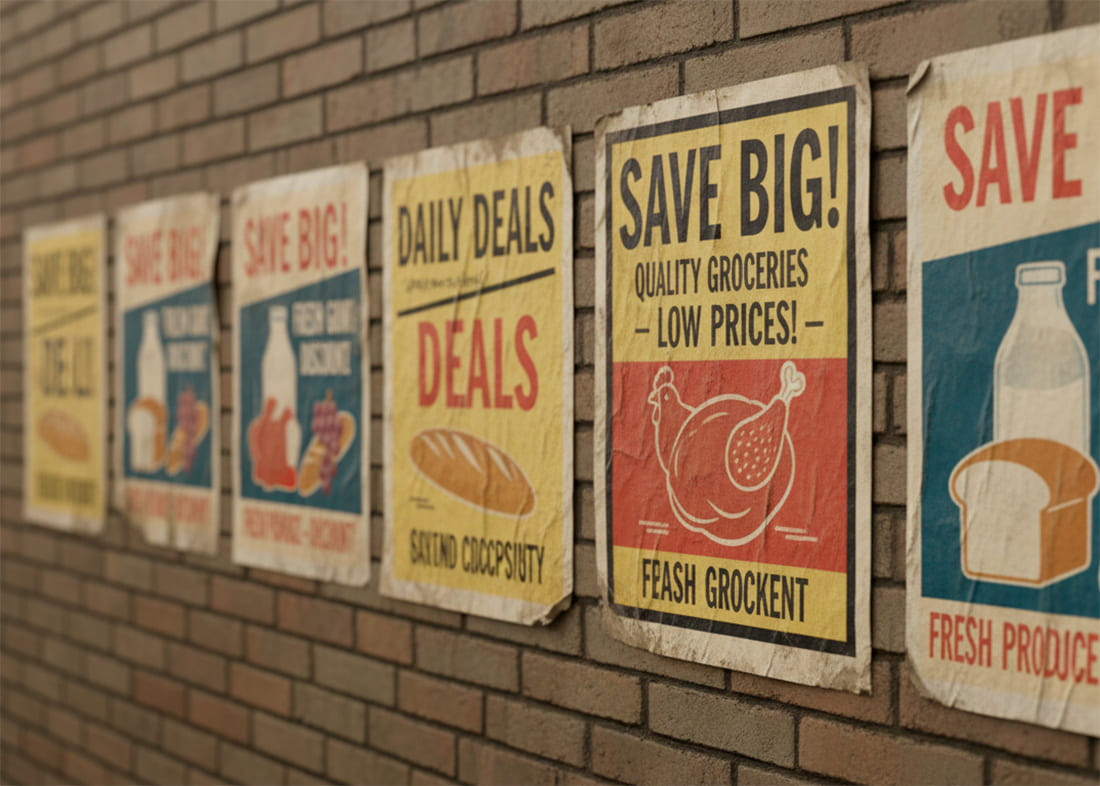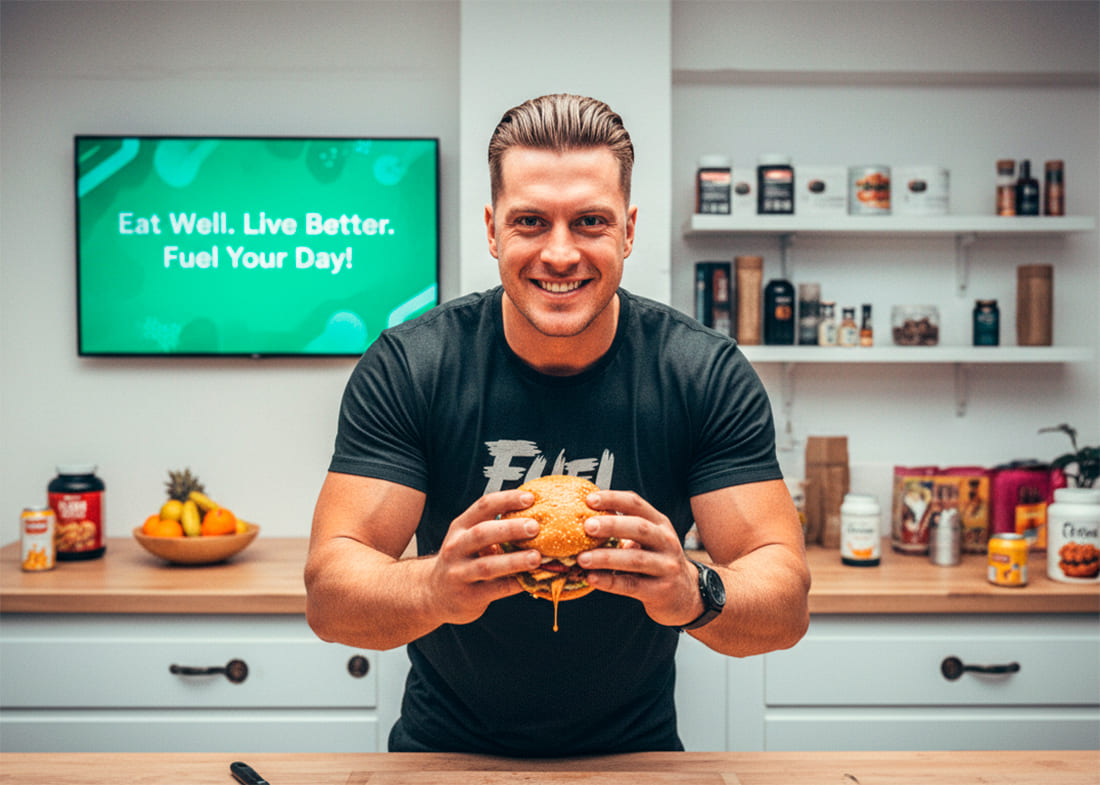
Native Marketing in the Food Industry: Building Trust Through Transparency
Native Marketing for Food Products
Native marketing for food products is a form of promotion where the product is not “sold directly” but shown in a real-life use case: in a recipe, a menu, a chef’s tutorial, or a story about ingredient sourcing. Unlike a banner or a shelf discount, this approach builds on trust and loyalty. It doesn’t push an immediate purchase—it explains why the product deserves a place in a consumer’s diet, a restaurant’s kitchen, or a retailer’s assortment.
For manufacturers, distributors, and retail chains, native marketing has become a practical tool for three reasons. First, consumers are tired of aggressive advertising and no longer trust “too good to be true” claims about taste and quality. Second, distribution channels have evolved: retailers and HoReCa operators now manage dozens of alternatives and their own private labels, so a brand can no longer rely on simply being “on the shelf.” Third, price dumping is no longer a sustainable strategy: retailers resist constant discounts, and restaurants don’t want to justify higher food costs to guests. That’s why food brands need a different model of influence — explaining the product’s value through its use, origin, and benefits rather than through “minus 20%” offers.
What Native Marketing Means in the Food Industry — and Why Brands Need It
Native marketing in food is about integrating the product naturally into a consumption context (home cooking, restaurant use, shelf display, or inclusion in a menu) rather than isolating it as an ad unit. This format is especially relevant in food, where trust defines choice: both consumers and buyers evaluate not just taste and price, but also origin, safety, and supply consistency. In retail, HoReCa, and e-commerce segments, loyalty is increasingly built not through promotions but through the feeling of “this product fits me, I know what I’m buying, and I know where it comes from.”
Unlike software or household appliances, food isn’t sold as a tool — it’s part of daily life and, in many cases, part of health. The buyer isn’t just looking for “tasty.” They’re looking for “safe for my child,” “won’t increase dish costs,” or “won’t harm the restaurant’s reputation.” Native marketing directly addresses these doubts. It shows the product’s journey — who makes it, how chefs use it, why the chain keeps the SKU in rotation without constant discounts — closing objections before the buyer reaches the shelf or the category manager opens their Excel matrix.
This approach benefits more than just the brand. Retail gains a clearly explained category value without eroding margins through discounts. HoReCa gains menu storytelling: guests are willing to pay more when they understand ingredient provenance. Distributors gain content they can send to buyers instead of aggressive commercial pitches.
How Native Marketing Differs from Hidden Advertising in the Food Segment

Native marketing in the food sector differs from hidden advertising because it doesn’t disguise commercial messaging as independent opinion. The content can be branded or partner-based, but it honestly presents the product in context, explaining its value without manipulative claims. Hidden advertising, by contrast, masks paid promotion as a “personal choice” or “independent review” without disclosing vested interest.
This distinction is critical in the food industry for two reasons. The first is safety and trust. When a brand positions its product as “natural,” “farm-made,” or “clean label” (a short, transparent ingredient list without unnecessary additives) but promotes it through vague personal testimonials like “I eat this every day,” audiences perceive that as pressure. Consumers—especially parents—read this as manipulation. The second reason is regulatory compliance. Food categories, particularly those for children, wellness, or functional nutrition, are subject to strict claims rules. If a brand promises “boosts immunity,” “supports weight loss,” or “safe for all children” but frames it as a “blogger’s personal experience,” that becomes a legal risk zone.
Strong native content doesn’t hide the brand. It doesn’t pretend it isn’t there. On the contrary, it demonstrates how the product works and explains the choice: where the ingredients come from, why a certain process is used, and what retail or HoReCa gains by including it in their range. It’s not advertising taste — it’s defining the product’s position.
Where the Legal Line Lies Between “Native Content” and “Advertising”
The legal boundary appears where product claims and undisclosed commercial interests intersect. If a brand or publisher talks about a product, makes consumer benefit claims (“healthy,” “safe,” “suitable for children,” “improves well-being”), and has a financial interest in its sales, such material must be labeled as advertising or partnership content. This isn’t a matter of taste — it’s a matter of compliance with truth-in-advertising standards for food and functional products.
For marketers, this means one thing: never hide commercial participation behind a supposed “chef’s review” if the chef is a paid ambassador. Don’t use medical-like language if the product is a regular food item without verified effects. Don’t make claims that aren’t substantiated. This is especially sensitive in “healthy eating,” children’s food, sports nutrition, and functional beverage categories.
Honest labeling such as “partner content” doesn’t undermine trust when the material itself is useful. In B2B and HoReCa, it’s often the opposite: buyers see it as a transparent supplier offer and appreciate that they’re being given materials for internal justification. Manipulation, on the other hand, signals risk — and risk is a reason to remove a product from rotation.
Why the Food Audience Rejects Aggressive Sales
Food is one of the most trust-sensitive categories. A buyer isn’t just choosing a yogurt, snack, or sauce brand — they’re making a decision tied to family, health, and diet quality. In B2B, the same logic applies: chefs and category managers are responsible for both the establishment’s reputation and shelf turnover. Aggressive selling (“best quality on the market,” “most beneficial formula,” “only today”) triggers skepticism rather than purchase intent.
There’s also saturation fatigue. The food sector has long relied on heavy promotions. Retail chains are used to pushing discounts; consumers are used to seeing “minus 30% for three days.” In this environment, any exaggerated promise feels like yet another short-term push. But the market is shifting. Discounts are more frequent, margins are thinner, and competition from private labels is growing. People are no longer choosing “what’s cheapest today” but “who I trust consistently.” If a brand keeps talking in the language of aggressive promos, it misses long-term trust—and without trust, it won’t stay on the shelf.
Finally, there’s the issue of safety and origin—especially for “healthy,” farm, imported, or functional products (protein drinks, lactose-free alternatives, etc.). Consumers want visibility into the product’s journey: where ingredients come from, where it’s packed, how it’s stored, and which professionals use it. That transparency is the essence of native marketing. Any aggressive formula doesn’t accelerate sales—it cancels that trust-building and reverts the brand to “just another name from an ad.”
Why Banners and Direct Offers Don’t Work in Food Marketing

Traditional banners and “buy now” offers don’t work in food marketing because they fail to answer the market’s key question: why should this product earn a place in someone’s diet or on a retailer’s shelf? A banner delivers a call to action. Native marketing delivers context—a recipe, a process sheet, provenance, or menu application.
To consumers, a banner is just noise. It doesn’t explain flavor, ingredients, sourcing integrity, or storage conditions. For buyers, it’s even less useful: category managers or chefs don’t make procurement decisions based on emotional offers. They need reasoning about supply stability, dish cost, logistics, shelf life, and menu fit. A banner provides none of that—native content does.
Food products “sell” at the moment of real-world use: when someone cooks dinner, when a guest chooses from a menu, or when a buyer decides how to fill the space between a private label and a well-known brand. Native formats integrate directly into those moments. Banners live outside them.
How Consumers and Buyers Evaluate Brand and Product Quality Today
Today, food products undergo an informal audit before purchase. In retail and e-commerce, consumers look at several factors in sequence: the ingredient list (is it short and clear?), origin (“farm-grown,” “local,” “antibiotic-free”), visual proof (how it looks in real life, not just in catalog shots), and reviews or user-generated content. UGC (User Generated Content — real photos, packaging breakdowns, home-cooking videos) has become what in-store tastings once were: personal validation — “I tried it, here’s how it really is.”
In HoReCa and distribution, the review is even stricter. Buyers assess not only taste and price but also batch consistency, logistics, storage conditions, delivery alignment with menu cycles, and compliance documentation. They don’t read brand slogans; they look for proof that the product already performs well in another kitchen or retail chain. That’s why content like “the chef cooks with our ingredient in their own kitchen” has far more impact than a branded presentation. It looks like evidence, not promotion.
For retail chains, this directly relates to listing risk. A product without transparent sourcing, a clear usage scenario, or a story explaining “how to sell it on the shelf” is more vulnerable to being replaced by a private label. In other words, poor native marketing is a direct risk of losing shelf space—even if the product itself is high-quality.
How to Measure Native Marketing Effectiveness in the B2B Food Segment

Native marketing for food products is measured not by clicks or reach but by the level of trust and engagement within the professional audience. The outcome isn’t immediate sales—it’s inclusion in supplier shortlists, product recognition, and buyer readiness to initiate contact. Metrics should reflect how effectively the content moved the audience from awareness to commercial interest.
Which Metrics Actually Reflect Native Campaign Performance
The main indicators of success for native marketing in food are content engagement, brand preference growth, and frequency of specification or supply inquiries. If people don’t just view the material but save recipes, watch videos to the end, or share them with colleagues, it means the content has become part of their product evaluation process.
Engagement Metrics
Engagement shows how useful and relevant the content proved to be. For food brands, this can include:
- video recipe and tasting completion rates;
- saves of materials with dish process sheets;
- downloads of specifications or price lists;
- click-throughs to product cards from industry articles.
Unlike likes and comments, these actions are closer to real intent—they show that people want to return to the information, apply it in their work, or share it with colleagues in procurement.
Trust and Brand Preference Metrics
A key success indicator is when the brand becomes a “default supplier.” This shows up as more shortlist mentions, more requests for samples or price sheets without active pitching, and fewer objections compared to competitors.
When a buyer or chef starts referencing the brand during assortment discussions, it means native content has worked—it has embedded the product into the professional language of the market.
How to Connect Native Content with Real B2B Leads and Procurement
The goal of native marketing in B2B is not a “like” but a conversation with the buyer. Well-structured communication leads to actions: requesting a sample, discussing logistics, clarifying seasonality of supply. That’s why attribution must capture not only digital indicators but also real steps along the sales chain.
Signals That a Buyer Is Ready to Engage
The signs are familiar to any sales team:
- a request for a price list or batch specification;
- interest in shelf life, packaging formats, and storage conditions;
- clarification of logistics routes;
- questions about supply stability across seasons;
- registration for a webinar or participation in a tasting.
If these signals appear more frequently after native content, that is direct evidence of campaign effectiveness.
How to Track the Path “Content → Conversation” Without a Direct “Buy Now” Link
In native campaigns, buyers rarely click a button. To see the effect, track the in-between steps: “request specifications” forms, price-list downloads, clicks to the product card in the catalog, subscriptions to industry newsletters. Record these actions in the CRM as micro-conversions. Together, they show the brand moving from “I’ve heard of it” to “I’m considering it as a supplier.”
Brand Lift for Taste, Origin, and Quality
Native marketing in food influences not only sales but also brand perception—brand lift. When the audience starts associating the product with specific qualities (for example, “clean label,” “local sourcing,” “reliable supply”), the likelihood of repeat purchase and shelf return increases.
Why Origin Stories Sometimes Outperform Discounts
An origin story creates a sense of predictability. In highly competitive segments with narrow price corridors, transparency and trust in the producer become decisive. Buyers more readily choose a product without a discount when they know where and by whom it is made and trust that quality won’t vary from batch to batch.
How to Verify That the Audience Links the Product to Specific Qualities
A practical method is surveys and content tests. If, when shown a neutral image, people name the key attributes (“farm-made,” “clean label,” “stable supply”), the brand associations have taken hold.
In B2B, this is visible in the number of repeat inquiries and contract stability. In such cases, native marketing works as a system of proof: it doesn’t just build awareness—it reduces the risk of rejection during procurement.
How Food Native Marketing Shifted from Discounts to Origin

Over the past decade, food marketing communications have been reshaped. Where attention was once bought with discounts, promotions, and loud campaigns, today brands have to earn trust. Price competition has crowded out dialogue: shelves are saturated, and discounts no longer persuade. Taking their place is content about origin, processes, and the people behind the product.
The shift toward transparency isn’t an aesthetic choice. It stems from consumer fatigue with aggressive marketing and from retailers’ focus on margin management. As private labels began offering comparable items at lower prices, brands realized that meaning—not markdowns—sustains them. Origin stories, process transparency, and proof of supply stability have become the new currency of trust.
Modern consumers aren’t looking for “the cheapest.” They want to understand why a product is worth the price and whom they can trust. Hence the growing interest in local farm narratives, sustainable production, short ingredient lists without unnecessary additives, and content featuring real people—technologists, chefs, suppliers.
How Brands Sold Food Ten Years Ago
In the 2010s, food advertising revolved around promo mechanics. Price and taste were the main arguments. TV integrations, banners, and tastings fueled instant demand: people saw a promotion and bought.
But this approach quickly ran its course. Once the promotion ended, interest faded and loyalty never formed. The price race reduced products to “just another item on the shelf,” and even strong brands lost ground.
Why “Price Tag and Shelf Space” No Longer Suffice
Shelf presence is no longer proof of quality. Private labels have filled most price tiers with comparable products at lower cost. In this environment, a brand can’t rely on placement alone—it must explain why its product deserves attention.
The market has shifted from mere visibility to substantive proof: ingredient origin, clean label, production process, and the maker’s story. This isn’t advertising; it’s evidence that preserves margin and reduces dependence on promotional pressure.
How Professional Buyers Choose Suppliers Today
Buyers no longer respond to slogans or emotional promises. They evaluate the operating model: supply stability, documented origin, manufacturer reputation, and the brand’s willingness to support the category with information.
They don’t need a flashy presentation—they need facts. Plant-floor videos, HoReCa case studies, technical commentary, and examples of product application outperform promo materials.
Native content becomes a reliability signal—not just a promotion format.
The Role of Supply Chain Transparency
A supplier who can show the product’s journey from farm to kitchen gains a natural advantage. For professional audiences, this is no longer goodwill but a marker of operational maturity.
Retailers and HoReCa increasingly expect this level of openness: documented origin data, footage from packing lines, interviews with technologists, and clear descriptions of storage and logistics. All of this is treated as part of the evidence base, not PR.
When a buyer sees real production and the people behind it, the brand stops being an abstraction. It becomes a partner trusted with the category—and in this industry, trust outweighs any discount.
Why “30 Years on the Market” No Longer Persuades on Its Own
A company’s age is no longer synonymous with reliability. For the professional market, relevance matters more than tenure.
Buyers want to know how the brand operates today: which standards it follows, how consistently it fulfills contracts, how quickly it responds, and how transparently it works. Even a well-known name that won’t show its processes appears outdated.
Longevity without proof is a memory, not an argument. In today’s context, trust is built by transparency, not by years in business.
Why Food Platforms Have Become Media
Retail chains, marketplaces, and industry platforms are no longer just points of sale. They have become media spaces where audiences seek knowledge and validation.
Factory videos, category breakdowns, chef guidance, and manufacturer case studies have become standard formats. Brands that integrate into this system win twice: they earn organic trust and maintain expert status without intrusive ads.
Origin stories have replaced discount banners. Trust is now created by the quality of explanation, not the quantity of placements.
Content as Trust Infrastructure Between Supplier and Buyer
Joint publications, interviews, industry reviews, and production-floor videos form a new collaboration infrastructure. In this environment, brands and buyers interact through knowledge, not pushy offers.
Content helps retailers justify category choices to consumers and helps HoReCa explain menu items to guests.
In this way, native marketing stops being a promotional tool and becomes part of professional communication that strengthens relationships and reduces dependence on price competition.
When Native Marketing Becomes Manipulative and Loses Trust

Native marketing loses effectiveness when it stops being honest and turns into pressure. For food audiences, trust outweighs polish: overly idealized scenes, hidden commercial motives, and aggressive promises backfire. Manipulation doesn’t strengthen the brand—it destroys what native formats are meant to build: a sense of reality and product safety.
The Risk of Replacing Expertise with Ad-Speak
The main mistake is using ad-speak where the audience expects expert facts. A buyer, chef, or category manager spots grandiose slogans instantly and disengages. Native content must read like an argument—not like “be inspired by our taste.”
When a piece turns into a pile of adjectives—“the best,” “the most delicious,” “absolutely natural”—it stops being content and starts looking like a promo leaflet. The result is predictable: trust drops, and the brand is perceived as a superficial player.
When a Perfect Picture Starts Undermining Trust
A typical trust loss happens when a kitchen is shown as overly sterile and staged. Actors smile, ingredients are arranged flawlessly, and equipment gleams like a home-appliance ad. In reality, food production involves people, processes, and nuances.
If models replace real staff and technologists, viewers sense the swap. This is especially obvious in B2B: a chef knows that kitchen doesn’t exist; a buyer sees the fake. Content should show production honestly—with noise, details, and real work in progress. Only then does it build trust.
The “Aggressive Influencer” Scenario
Another extreme is a blogger or chef who doesn’t share experience but pushes a hard sell. Such integrations don’t feel native, even in story formats. Audiences quickly tell the difference between genuine opinion and a paid brief.
If the influencer talks more about the product than the process, trust erodes for both—the creator and the brand. In food, this is especially damaging: people link food to personal choice and don’t forgive pressure.
Legal and Reputational Risks for Food Brands
In food, the line between “native demonstration” and a legal breach is thin. Any claim about health benefits, safety, or therapeutic properties must be documented. If content is created with brand involvement, that partnership must be disclosed. Transparency isn’t a formality—it protects against complaints and reputational loss.
Which Claims Are Risky
Phrases like “boosts immunity,” “heals,” “suitable for all children,” or “improves well-being” are especially risky. Such claims require scientific evidence and, in some cases, registration if the product isn’t specialized nutrition.
You also can’t imply medical effects when speaking about regular food. Even in native formats, distinguish clearly: you can discuss composition and process—but not physiological impact.
Why Honest “Partner Content” Labeling Doesn’t Hurt B2B Performance
Labels like “partner content” or “joint project” don’t reduce trust when the content is truly useful. In B2B, transparency actually elevates a brand’s status as a reliable partner. Buyers and chains treat open formats as professional knowledge-sharing, not advertising.
Brands that clearly state their involvement win twice: they avoid legal risk and demonstrate communication maturity. For industry audiences, that signals reliability.
How to Launch Native Campaigns That Build Trust—Not Irritation
Effective native campaigns are built on utility, not emotion. The brand’s job is to explain the product through real context: where and how it’s used, what it solves for partners, and how it helps grow margin without discounts. If a piece answers a working question, it’s perceived as value—not an ad.
Where to Actually Start: Are You Selling Taste, Process Efficiency, Supply Stability, or Partner Margin?
- Define the product’s core meaning before you publish.
- If you bet on taste—show how it works in a menu or recipe.
- If your edge is process efficiency—demonstrate packing, storage, and batch handling.
- If the key is supply stability—highlight logistics and predictable volumes.
In B2B, you need a precise answer to “what problem do we solve for the client?”—your native strategy grows from there.
How to Select the Primary Use Case
- For B2C: a recipe, a family story, or a “zero waste” tip.
- For B2B: a restaurant case where the ingredient cuts costs or stabilizes the menu.
- For retail: a shelf solution—why the SKU earns its space without constant promotions.
- The scenario must be simple and credible: not “tasty and healthy,” but “helps chefs avoid menu changes during seasonal swings.”
How to Turn a Scenario into Content—Not a Commercial

The rule: show the process, not the slogan. Put real people on screen, not actors. A short video with a technologist beats an expensive staged production with a voice-over. Native starts where the brand demonstrates rather than declares.
Content must answer: “What will the viewer learn?” If there’s a clear answer, it’s native. If not, it’s advertising.
Where to Publish So It Feels Organic—Not Bought
The best venues are where the audience solves real tasks: industry marketplaces, trade media, retailer and HoReCa blogs. Content should appear in its natural habitat—among real articles, instructions, recipes, and cases. Then it reads as professional exchange, not an ad insert.
Industry B2B Platforms or Supplier Marketplaces
For manufacturers and distributors, these platforms are a direct route to buyers. Format content as expert articles, category reviews, or technologist interviews. Speak the market’s language: not “buy from us,” but “here’s how to solve your supply challenge.”
Retailer and Chain Platforms
In chain retail, native isn’t a poster—it’s a useful collection: recipes built from available SKUs, product origin stories, “pair with wine” sets, or “display solutions.” This content lifts category sales and helps the chain retain customers without discounts.
Your Own Brand Knowledge Hub
A knowledge hub is a library about the product: recipes, process sheets, storage standards, and factory-line videos. It replaces brochures and decks, turning the brand into a data source. For partners, it’s convenient for negotiations and staff training. For search engines and LLMs, it signals authority.
The Trade-Offs You’ll Need to Accept
Any native strategy balances speed and depth. Fast content drives reach but rarely builds trust. Deep expert pieces work slower, but they position the brand as a reliable supplier. Successful companies alternate formats while staying truthful and visually honest.
Speed of Reach vs. Depth of Trust
Posts and short videos attract attention but don’t create expert perception. Articles, case studies, and instructional videos take longer yet build a stable brand image. The optimum is a mix: quick formats for entry, analytical ones for reinforcement.
Content Aesthetics vs. Production Credibility
Overly perfect visuals reduce credibility. Food production always has detail: noise, packing, working hands, ingredients. Show it. For food audiences, that’s not a “flaw” but proof of reality. Beauty must be functional—clean frames matter less than a sense of honesty.
Expert Advice
“In food, you’re not selling taste—you’re selling confidence that the taste will be the same tomorrow.”
This line captures the essence of native marketing in the category. Its job isn’t an emotional spike—it’s building predictable trust. When partners or consumers are sure the product is consistent, the brand doesn’t need discounts or loud promises.


 Español
Español Русский
Русский






